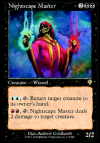 |
 I’m sure
you’ve seen them. Hunkered down in dorm
rooms, in their parents basement, in comic book shops, in the break room at work,
twitching while they shuffle their cards, eyes searching for the next great combo. Their hands periodically flash a card and they
exchange libraries of strange sounding terminology and definitions. Maybe you though it was a cult. Maybe you were right. I’m sure
you’ve seen them. Hunkered down in dorm
rooms, in their parents basement, in comic book shops, in the break room at work,
twitching while they shuffle their cards, eyes searching for the next great combo. Their hands periodically flash a card and they
exchange libraries of strange sounding terminology and definitions. Maybe you though it was a cult. Maybe you were right. In the years since
its launch, Magic the Gathering has grown into the epitome of cultural phenomenon. With an estimated fan base of around seven million
active players from fifty-two countries, Magic is everywhere. Lest you thing Magic the Gathering is confined to
junior-high-school playgrounds, think again. With
a worldwide tournament schedule that includes a 1.5 million-dollar pro tour and a yearly
world championship tournament with a $250, 000 purse, the stakes are high and the
competition is intense. I’ve always
loves games. All of them, but strategy games most of all. I think I’ve played almost
all of them, and only a couple stick out in my mind as truly worthy of pursuit. When I was
a kid I played a lot of chess, and as an adult I play a lot less chess but it’s still
an amazing game. Their comes a time in chess
where you hit the wall of your natural aptitude and in order to improve you’re going
to have to study the game. No matter how much
you love the game, spending three hours a day memorizing different lines from Bobby
Fishers poisoned pawn or the Kasparov system of the King’s Indian defense is going to
get old sooner or later. Probably sooner.
In an effort to
keep the game fresh and exciting, Wizards of the Coast releases periodic expansion to the
Magic universe. Some are excellent, some are
only pretty good. Their newest expansion,
Invasion, happens to be awesome—It’s one of the best ever released. Invasion sports a
lot of new features never seen before. Some
new cards now have a kicker, an optional casting cost that can boost the effect of a card
later in the game, at the cost of a slightly less effective cost early in the game. In addition, the new set also introduces the split
card, a card with two mini cards printed on each card.
Each half is less effective then a comparable spell would be, but the added
flexibility of having two choices of which card to take can more than make up for the
deficiency.
Legends have
returned, including those extraordinarily powerful dragon legends, only unlike the ones
that were printed in the Legends expansion set, these dragons are actually playable. Gold cards have also returned in Invasion, and
they’ve returned in massive numbers. Only
unlike most of the gold cards that have been printed throughout Magic history, these gold
cards don’t suck. These gold cards are
not only some of the best in the set, they’re also some of the best in print, and
maybe some of the coolest cards ever made-- which is yet another reason why three and four
color decks will see a surge in popularity. Trust me on this
one. Invasion is an awesome set, and a
welcome sight after the adequate, but rather prosaic Mercadian Masques block cycle and the
disappointingly shallow Prophecy expansion set. Invasion
delivers with ingenuity and style, and the Standard tournament cycle is about to take a
decidedly cool turn. If you’re a Magic
fan or have been thinking about giving it a whirl, this is a can’t miss set. The Invasion block cycle will be completed with
the release of Odyssey in October of 2001, Vendetta in February of 2002, and Judgment in
June 2002. |